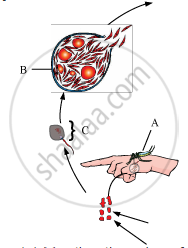Advertisements
Advertisements
Question
Mention any four methods involved in the treatment of cancer.
Solution
Treatment of Cancer:
It depends upon the type of cancer. There are four types of cancer treatment strategies which are used singly or in combination.
(i) Surgery: The tumour is removed surgically. However, as a malignant tumour has migrating cells, the latter cannot be removed. Therefore, surgical removal of a malignant or cancerous tumour is never completely successful. Certain tumours are, however, not accessible to surgical excision. In some of these lasers, microsurgery has been used successfully.
(ii) Radiation Therapy: Cancer cells are undifferentiated dividing cells. They are more easily damaged by radiations than the other differentiated body cells. Radon (Rn-220), Iodine (1-131) and cobalt (Co-60) are radioisotopes commonly used in radiotherapy. However, some harmful changes do occur to normal tissues around the tumour mass.
(iii) Chemotherapy: It is the use of cytotoxic drugs often along with other types of therapies. The common drugs are cisplatin and fluorouracil, nitrosoureas, vincristine and vinblastin (from Catharanthus roseus in leukaemia), taxol (from Taxus baccata) and tetrathiomolybdate. Cytotoxic drugs, however, have a number of side effects.
(iv) Immunotherapy: It is strengthening of the anticancer immunological defence mechanism of the body because tumour cells avoid detection and destruction by the immune system. For this, the patients are given biological response modifiers such as a-interferon. They activate the immune system which helps in destroying tumour cells. Monoclonal antibodies with attached radioisotopes combine immunotherapy with radiotherapy. Another approach is to develop vaccines against cancers. Bone marrow transplant is used in case of leukaemia.
APPEARS IN
RELATED QUESTIONS
Study a part of the life cycle of malarial parasite given below. Answer the questions that follow:

(a) Mention the roles of ‘A’ in the life cycle of the malarial parasite.
(b) Name the event ‘C’ and the organ where this event occurs.
(c) Identify the organ ‘B’ and name the cells being released from it.
Name the causative organism of the disease amoebiasis. List three symptoms of the disease.
Mention the causative agent and the preventive measures for the following: Pneumonia.
Exo-erythrocytic schizogony of Plasmodium takes place in ____________.
How is this disease transmitted?
| Diseases | Causative agent | Symptoms |
| Ascariasis | Ascaris | |
| Trichophyton | Appearance of dry, scaly lesions on various parts of the body | |
| Typhoid | High fever, weakness, headache, stomach pain and constipation. | |
| Pneumonia |
The sporozoites that cause infection when a female Anopheles mosquito bites a person, are formed in ______.
Which of the following is not the causal organism for ringworm?
“Maintenance of personal and public hygiene is necessary for prevention and control of many infectious diseases”. Justify the statement giving suitable examples.
Write the scientific name of the causative agent of the following diseases:
Typhoid
